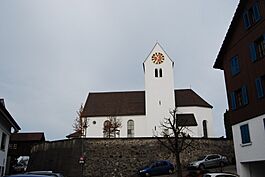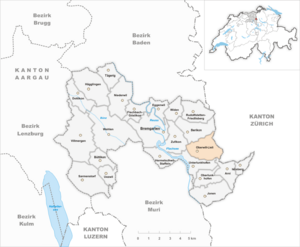Oberwil-Lieli facts for kids
Quick facts for kids
Oberwil-Lieli
|
||
|---|---|---|
 |
||
|
||
| Country | Switzerland | |
| Canton | Aargau | |
| District | Bremgarten | |
| Area | ||
| • Total | 5.35 km2 (2.07 sq mi) | |
| Elevation | 530 m (1,740 ft) | |
| Population
(Dec 2020 )
|
||
| • Total | 2,501 | |
| • Density | 467.5/km2 (1,210.8/sq mi) | |
| Postal code |
8966
|
|
| Surrounded by | Aesch bei Birmensdorf (ZH), Arni, Berikon, Birmensdorf (ZH), Unterlunkhofen, Zufikon | |
Oberwil-Lieli is a small town, also called a municipality, located in the Aargau canton of Switzerland. It's part of the Bremgarten district. This charming place is known for its quiet neighborhoods and beautiful views.
Contents
History of Oberwil-Lieli
People have lived in the area of Oberwil-Lieli for a very long time. During the Roman times, there was a Roman farm where the church stands today. Scientists have also found old ruins from an Alemanni settlement in the town.
The town was first mentioned in a document in 1040. Back then, it was called Willare. Land in the village was given to important places like Einsiedeln Abbey, Engelberg, and Muri Abbey.
Over the centuries, different powerful families and cities controlled the area. For example, the Counts of Habsburg-Laufenburg once had rights here. Later, in 1429, the city of Bremgarten gained control. After 1415, the city of Zurich also had some power over Oberwil.
The local church, St. Michael, has a tower from the 11th century. The church building was damaged in wars in 1445 and 1656. The church you see today was built between 1672 and 1673.
For a long time, people in Oberwil-Lieli grew grapes for wine. But after 1860, the vineyards declined. This caused the population to shrink until 1960. Since then, many new homes have been built. The town has grown a lot, especially because it's close to Zurich.
The two villages, Oberwil and Lieli, joined together in 1908 to form one municipality called Oberwil. In 1984, it was officially renamed Oberwil-Lieli.
Geography and Landscape
Oberwil-Lieli covers an area of about 5.4 square kilometers (about 2 square miles). A large part of the land, almost 58%, is used for farming. About 27% is covered by forests. The rest of the land is used for buildings and roads.
The town is located in the Reuss river valley. It sits on a high, flat area called a terrasse. Oberwil-Lieli is made up of two main villages: Oberwil and Lieli.
Coat of Arms
The official symbol of Oberwil-Lieli is its coat of arms. It shows a green pear tree with golden pears on a silver background. This pear tree represents the Holzbirrliberg, which is a mountain where the village is located.
Population and People
Oberwil-Lieli is home to about 2,300 people. Over the last ten years, the population has grown quite a bit, by about 23%. Most people in Oberwil-Lieli speak German. A smaller number of people speak Italian or English.
In 2008, about 11% of the population were children aged 0 to 9 years old. About 10% were teenagers aged 10 to 19. This means that a good portion of the town's residents are young people.
Many people in Oberwil-Lieli own their homes. In 2000, about 67% of households owned their homes instead of renting. The average household had about 2.45 people living in it.
Economy and Jobs
In 2007, the unemployment rate in Oberwil-Lieli was very low, at only 1.4%. This means most people who wanted a job had one.
Many people in Oberwil-Lieli work in different kinds of jobs:
- Farming: About 88 people work in farming.
- Manufacturing: Around 44 people work in factories or making things.
- Services: The largest group, about 177 people, work in service jobs. This includes things like shops, offices, and other services.
Most people who live in Oberwil-Lieli travel outside the town for work. About 78% of residents work in other places. About 18% of people use public transportation to get to work, while over 53% use a private car.
Religion
According to a census in 2000, about 41.9% of the people in Oberwil-Lieli were Roman Catholic. Another 38.3% belonged to the Swiss Reformed Church.
Education
Children living in Oberwil-Lieli attend Schulhaus Falter for their primary education.
For older students, there are several secondary schools nearby:
- Alte Kantonsschule Aarau
- Kantonsschule Baden
- Kantonsschule Wohlen
- Neue Kantonsschule Aarau
Images for kids
See also
 In Spanish: Oberwil-Lieli para niños
In Spanish: Oberwil-Lieli para niños










